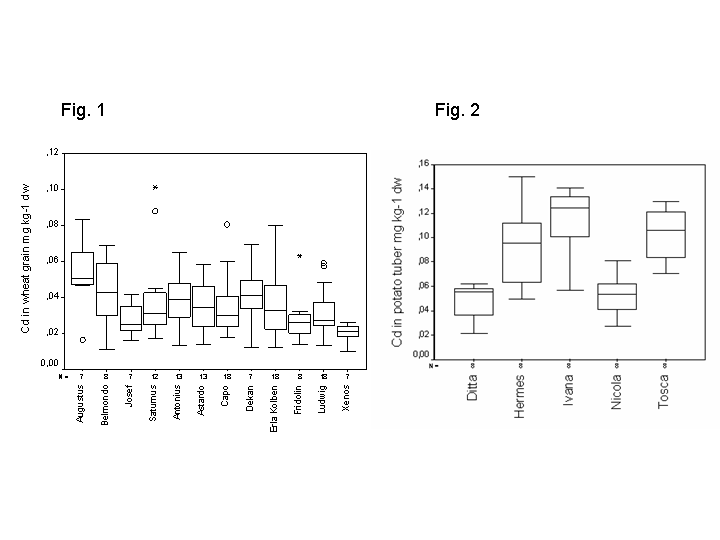
Saturday, 15 July 2006
168-17
Cadmium in Austrian wheat and potatoes - an inventory of sites and varieties.
2. Materials and Methods Eighteen representative sites for the Austrian wheat and eight for the potatoes growing zones (soils and crops) were investigated. On each site Cd in 4 to12 varieties of wheat (n=136) and in 5 varieties of potatoes (n=40) was analysed. Cd concentrations (Aqua Regia) in the soils did not exceed 0.65 mg kg-1.
3. Results and Discussion The Cd concentrations in all investigated foodstuff samples were well below the EU limit values (for wheat: 0.2 mg kg-1 fw corresponding to 0.233 dw, for potatoes: 0.1 mg kg-1 fw corresponding to 0.5 mg kg-1dw, assuming an average dry matter content of 86% resp. 20%). The median Cd-value of wheat was 0.030 mg kg-1 dw (with range of 0.010 and 0.101 mg kg-1), significant differences between varieties could be observed. For wheat varieties the mean Cd concentration was significantly lower in Xenos compared to Capo and highest in Augustus (see Figure 1). Potatoes Cd concentration varied between 0.022 and 0.150 mg kg-1 dw (median: 0.077 mg kg-1 dw) with significant differences between the varieties Ivana > Hermes > Ditta (see Figure 2). A significant relationship between the pH of the surface soil (0-20 cm) and the Cd concentration in potato tubers (R2=0.65) and wheat grain (R2=0.33) could be shown. A rough estimation of the daily Cd intake with wheat and potatoes revealed the following results. An average Austrian consumer (potatoes: 144 g day-1, wheat: 133 g day-1, BMLFUW, 2003) takes up 2.4 µg Cd day-1 with potatoes and 3.7 µg Cd day-1 with wheat (as wholemeal product). If he consumed only products of the varieties with the lowest Cd concentration (overall sites) the intake would only be 1.5 µg Cd day-1 with potatoes and 2.5 µg Cd day-1 with wheat. This means that the Cd burden with these products could be reduced by 35 % on the average with the selection of Cd poor varieties.
4. Conclusions Cd accumulation in potato tubers and wheat grain varies significantly with soil conditions, especially pH, and varieties. Because the latter are subject to fluctuation over time, changes may influence dietary intake considerably. Therefore Cd concentration in varieties should be investigated before implementation. In case of unfavourable soil conditions varieties with a low phyto-availability could be preferably grown.
References BMLFUW (2003): 2. Lebensmittelbericht Österreich. Bundesministerium für Land- und Forstwirtschaft, Umwelt und Wasserwirtschaft, Wien. Elmadfa, I., P. Burger (1999): Expertengutachten zur Lebensmittelsicherheit Cadmium, im Auftrag des Bundeskanzleramts. Jansson Gunilla (2002): Cadmium in Arable Crops. Doctoral thesis. Swedish University of Agricultural Sciences. Uppsala. Wenzel, W.W., Blum, W.E.H., Brandstetter, A., Jockwer, F., Köchl A., Oberforster, M., Oberländer, H.E., Riedler C., Roth K., and Vladeva, I. (1996): Effects of soil properties and variety on cadmium accumulation in wheat grain. Zeitschrift für Pflanzenernährung und Bodenkunde 159, 609-614.
Figure 1: Cd concentration in the different wheat varieties Figure 2: Cd concentration in the different potato varieties

Back to 4.2C Soil Quality as it Affects Nutrients in Food Crops and Human Health - Poster
Back to WCSS
Back to The 18th World Congress of Soil Science (July 9-15, 2006)